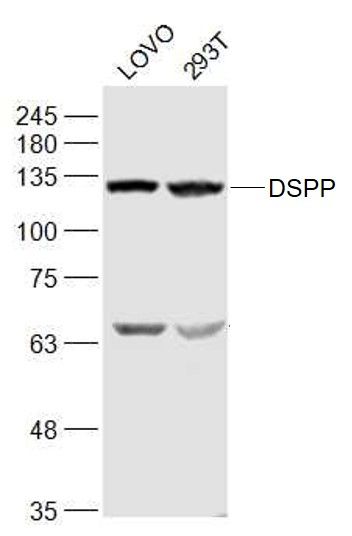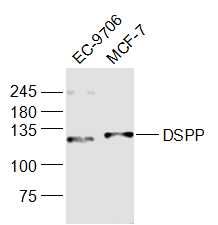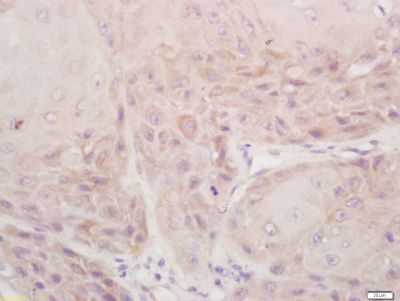产品中心
当前位置:首页>产品中心Anti-DSPP
货号: bs-10316R 基本售价: 780.0 元 规格: 50ul
- 规格:50ul
- 价格:780.00元
- 规格:100ul
- 价格:1380.00元
- 规格:200ul
- 价格:2200.00元
产品信息
- 产品编号
- bs-10316R
- 英文名称
- DSPP
- 中文名称
- 牙本质磷蛋白/牙本质骨唾液酸糖蛋白/牙本质骨唾液酸磷蛋白抗体
- 别 名
- Dentin phosphophoryn; Dentin phosphoprotein; dentin phosphoryn; Dentin sialophosphoprotein; Dentin sialophosphoprotein precursor; Dentin sialoprotein; dentinogenesis imperfecta 1; DFNA39; DGI1; DMP3; DPP; DSP; DSPP_HUMAN; DTDP2.
- 规格价格
- 50ul/780元购买 100ul/1380元购买 200ul/2200元购买 大包装/询价
- 说 明 书
- 50ul 100ul 200ul
- 研究领域
- 细胞生物 免疫学 信号转导 细胞周期蛋白 结合蛋白 细胞分化 细胞骨架 细胞外基质
- 抗体来源
- Rabbit
- 克隆类型
- Polyclonal
- 交叉反应
- Human,
- 产品应用
- WB=1:500-2000 ELISA=1:500-1000 IHC-P=1:400-800 IHC-F=1:400-800 ICC=1:100-500 IF=1:100-500 (石蜡切片需做抗原修复)
not yet tested in other applications.
optimal dilutions/concentrations should be determined by the end user.
- 分 子 量
- 47/129kDa
- 细胞定位
- 细胞外基质
- 性 状
- Lyophilized or Liquid
- 浓 度
- 1mg/ml
- 免 疫 原
- KLH conjugated synthetic peptide derived from human Dentin sialoprotein:31-130/1301
- 亚 型
- IgG
- 纯化方法
- affinity purified by Protein A
- 储 存 液
- 0.01M TBS(pH7.4) with 1% BSA, 0.03% Proclin300 and 50% Glycerol.
- 保存条件
- Store at -20 °C for one year. Avoid repeated freeze/thaw cycles. The lyophilized antibody is stable at room temperature for at least one month and for greater than a year when kept at -20°C. When reconstituted in sterile pH 7.4 0.01M PBS or diluent of antibody the antibody is stable for at least two weeks at 2-4 °C.
- PubMed
- PubMed
- 产品介绍
- background:
This gene encodes two principal proteins of the dentin extracellular matrix of the tooth. The preproprotein is secreted by odontoblasts and cleaved into dentin sialoprotein and dentin phosphoprotein. Dentin phosphoprotein is thought to be involved in the biomineralization process of dentin. Mutations in this gene have been associated with dentinogenesis imperfecta-1; in some individuals, dentinogenesis imperfecta occurs in combination with an autosomal dominant form of deafness. Allelic differences due to repeat polymorphisms have been found for this gene. [provided by RefSeq, Jul 2008]
Function:
DSP may be an important factor in dentinogenesis. DPP may bind high amount of calcium and facilitate initial mineralization of dentin matrix collagen as well as regulate the size and shape of the crystals.
Subunit:
Interacts with FBLN7.
Subcellular Location:
Secreted, extracellular space, extracellular matrix.
Tissue Specificity:
Expressed in teeth. DPP is synthesized by odontoblast and transiently expressed by pre-ameloblasts.
Post-translational modifications:
DSP is glycosylated.
DISEASE:
Defects in DSPP are the cause of deafness autosomal dominant type 39 with dentinogenesis imperfecta 1 (DFNA39/DGI1) [MIM:605594]. Affected individuals present DGI1 associated with early onset progressive sensorineural high-frequency hearing loss.
Defects in DSPP are the cause of dentinogenesis imperfecta type 1 (DGI1) [MIM:125490]; also known as dentinogenesis imperfecta Shields type 2 (DGI2). DGI1 is an autosomal dominant disorder in which both the primary and the permanent teeth are affected. It occurs with an incidence of 1:8000 live births. The teeth are amber and opalescent, the pulp chamber being obliterated by abnormal dentin. The enamel, although unaffected, tends to fracture, which makes dentin undergo rapid attrition, leading to shortening of the teeth.
Defects in DSPP are a cause of dentinogenesis imperfecta Shields type 3 (DGI3) [MIM:125500]. Patients with DGI3 do not have stigmata of osteogenesis imperfecta. The finding that a single defects in the DSPP gene causes both phenotypic patterns of DGI2 and DGI3 strongly supports the conclusion that these two disorders are not separate diseases but rather the phenotypic variation of a single genetic defect.
Defects in DSPP are the cause of dentin dysplasia type 2 (DTDP2) [MIM:125420]; also known as dentin dysplasia Shields type 2. DTDP2 is an autosomal dominant disorder in which mineralization of the dentine of the primary teeth is abnormal. On the basis of the phenotypic overlap between, and shared chromosomal location with DGI2 it has been proposed that DTDP2 and DGI2 are allelic. From the results of recent studies, it is clear that different types of mutations in DSPP lead to the two different phenotypes.
SWISS:
Q9NZW4
Gene ID:
1834
Database links:Entrez Gene: 1834 Human
Omim: 124585 Human
SwissProt: Q9NZW4 Human
Unigene: 678914 Human
Important Note:
This product as supplied is intended for research use only, not for use in human, therapeutic or diagnostic applications.
- 产品图片
 Sample:
Sample:
LOVO(Human) Cell Lysate at 30 ug
293T(Human) Cell Lysate at 30 ug
Primary: Anti-DSPP (bs-10316R) at 1/1000 dilution
Secondary: IRDye800CW Goat Anti-Rabbit IgG at 1/20000 dilution
Predicted band size: 47/129 kD
Observed band size: 67/129 kD Sample:
Sample:
EC-9706(Human) Cell Lysate at 30 ug
MCF-7(Human) Cell Lysate at 30 ug
Primary: Anti-DSPP (bs-10316R) at 1/1000 dilution
Secondary: IRDye800CW Goat Anti-Rabbit IgG at 1/20000 dilution
Predicted band size: 47/129 kD
Observed band size: 129 kD Tissue/cell: human laryngocarcinoma; 4% Paraformaldehyde-fixed and paraffin-embedded;
Tissue/cell: human laryngocarcinoma; 4% Paraformaldehyde-fixed and paraffin-embedded;
Antigen retrieval: citrate buffer ( 0.01M, pH 6.0 ), Boiling bathing for 15min; Block endogenous peroxidase by 3% Hydrogen peroxide for 30min; Blocking buffer (normal goat serum,C-0005) at 37℃ for 20 min;
Incubation: Anti-DSPP Polyclonal Antibody, Unconjugated(bs-10316R) 1:200, overnight at 4°C, followed by conjugation to the secondary antibody(SP-0023) and DAB(C-0010) staining

